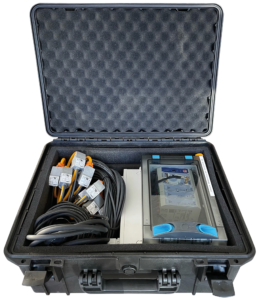20 March 2024
LACROIX SAE IT
Mobile telecontrol case: identify hotspots in the local network
“Top-down” from high voltage through medium voltage to low voltage at the end customer. In the past, distribution grids were planned and implemented according to a clear energy flow direction. Transformers, lines and protective devices were dimensioned based on the residential units to be supplied, typical load profiles, statistical simultaneity factors and a sufficiently large safety factor.
Intelligent nodes
The steadily increasing feed-in power from renewable energies and the change in energy consumption behavior, for example due to the advancement of e-mobility, have changed the classic planning model and the technology of electrical energy supply. These influences largely affect the low-voltage grid. Critical operating states and overloads can occur there, as the classically planned grids were not designed for this.
Local grid stations are increasingly becoming intelligent nodes: They take on tasks ranging from fault detection with fault location, power quality analysis to complete remote control or even automated disconnection point relocation. However, not all local network stations can usually be completely retrofitted, as the costs must be in relation to the benefits. Stadtwerke Kempen has therefore developed an interesting solution and presented it at the SAE Expert Days 2021: A mobile measuring case for low-voltage measurement.
In total, there are over 300 local grid stations in the municipal utility’s network. A global rollout of stationary LV measurement for all stations would not make economic sense and would not be manageable in terms of organizational effort. The new mobile low-voltage grid measuring case enabled Stadtwerke Kempen to identify “hotspots” in the grid and thus detect strategically important local grid stations in order to then set up stationary low-voltage measurement with SAE technology only at these “hotspots”.
At the heart of the Kempen municipal utility’s case is an FW-5-GATE-4G with three PM-1-R modules (for Rogowski coils). The advantage of SAE technology is the existing interfaces for direct connection to the control system via IEC -104 and LTE. The measuring interval is four weeks with monitoring of the transformer load and the individual outgoing circuits. In Kempen, there are 5-9 low-voltage outgoing circuits per transformer station. A number of “hotspots” that could lead to overvoltage or undervoltage in the grid were discovered, particularly in connection with the driving factors of electromobility (registration of wallboxes) and PV systems. An annual repetition is planned in order to recognize long-term developments and to be able to retrofit stationary LV measurements if necessary.
Current product development: Mobile telecontrol case
We are now taking the example of Stadtwerke Kempen as an opportunity to develop a standardized solution. Various concepts are already being examined and requirements collected in product management. Our aim is to develop a supplementary product that is versatile and flexible in use and meets the needs of our customers’ various systems and installations – thereby creating real added value.
is to develop a supplementary product that is versatile and flexible in use and meets the needs of our customers’ various systems and installations – thereby creating real added value.
The mobile telecontrol case should not only be used for temporary low-voltage measurements in local network or distribution substations to support you in detecting and analyzing anomalies during operation, but also in other mobile or stationary systems where temporary telecontrol monitoring is required. In addition, the mobile telecontrol case is intended to help with the planning and validation of structural measures and as support during commissioning.
A basic product is planned, which can be adapted to the requirements of a wide range of applications using specific options. Our product portfolio also offers various communication options, such as 4G LTE or 450 MHz.